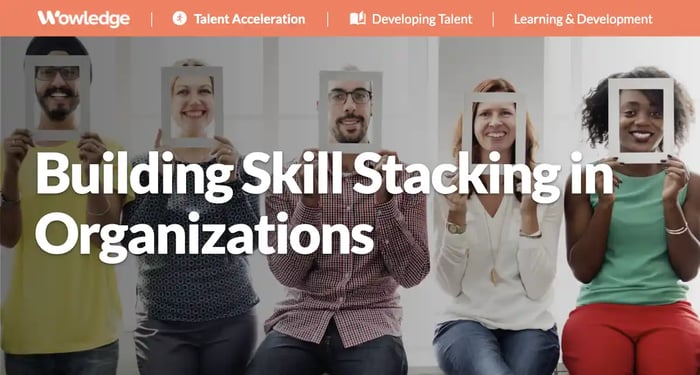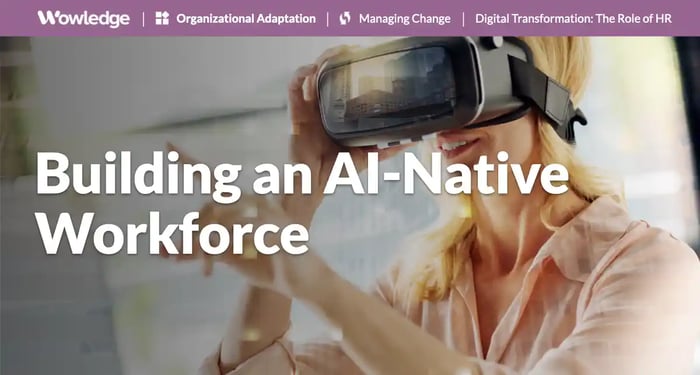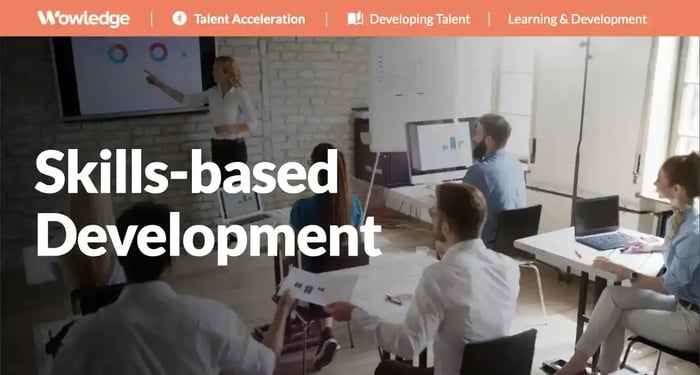Table of Contents
We are in a new world of careers. Many factors are driving this revolution, but the most prominent ones are the shifts in generational views on work and the changes in jobs with the growth of technology. Encouraging skill stacking is a strategy to help address those trends.
The World Economic Forum, in its Future of Jobs Report, states that “broadening digital access is expected to be the most transformative trend—both across technology-related trends and overall—with 60% of employers expecting it to transform their business by 2030.” With this organizational transformation comes job transformation. The report notes that 86% of respondents in the survey expect artificial intelligence (AI) and information processing technologies to bring changes to their business models. This will mean changes to jobs as well. In addition, the WEF finds that "on average, workers can expect that two-fifths (39%) of their existing skill sets will be transformed or become outdated over the 2025-2030 period.”
The good news is that this could already be at the peak of changes. Skill gaps or instability indicated in previous reports were reported at higher numbers than in the 2025 report. This trend could stabilize with the reskilling and workforce-planning initiatives already in place. The impact on careers is even more significant than reskilling and will have more prolonged effects. In a world where AI can now write poetry, compose music, and even code, the traditional notion of career specialization is rapidly becoming obsolete. The question is no longer 'What's your expertise?' but rather 'How diverse and adaptable is your skill stack?'
As artificial intelligence continues to master tasks once thought to be exclusively human domains, professionals across industries are grappling with an existential crisis: How do we remain relevant and valuable in a world where machines can potentially outperform us in our areas of specialization? The answer lies not in doubling down on a single skill set but in strategically building a diverse portfolio of complementary skills—a skill stack—that uniquely positions us to thrive in the AI-augmented workplace of tomorrow.
We are also seeing these shifts in how the workforce shows up concerning demographics. We are heading into a multigenerational workforce that brings five generations together—Baby Boomers, Gen X, Millennials, Gen Z, and Gen Alpha. Two dynamics will come into play during this multigenerational time. First, we will see Gen Z and Gen Alpha redefine work culture in multiple ways beyond the technological impacts. “Instead of replacing workers, AI may further enhance roles across all generations. There could be “a greater focus on emotional intelligence, creativity, and strategic thinking as automation handles repetitive tasks,” an article from Forbes predicts. Given the shifts that we already see in values that drive Gen Z and Gen Alpha, and even Millennials, with regards to finding purpose in their jobs, less loyalty to companies, and a proclivity to inclusion and wellness, we should see the so-called softer skills be fostered and leveraged more in the age of AI. We may also see intergenerational learning and micro-mentoring being pushed, as someone’s experience in a role may not necessarily be the key to success in future iterations.
Building resilient, AI-resistant skill sets in our employees and creating organizations that foster a culture that nurtures this new paradigm of professional growth will be a requirement for the future workplace. Taking steps now will set the organization up for success in the latest, ever-changing, competitive world and create a workplace of engaged and qualified employees for this new reality.
What is skill stacking?
Skill stacking is not a new concept, but given these changes, it is becoming more of a necessity than a plus. Indeed's career advice blog post defines skill stacking as “the concept that individuals can make themselves more valuable by gaining a wide range of skills instead of pursuing one skill or talent.” It is more than just learning new things. It is about intentionally expanding one’s skills into areas that may not be traditionally relevant to their role today.
A lot has been written about the top skills needed in the new workplace, which are the softer skills—analytical, problem-solving, resilience, and more. These are foundational skills that are developed by expanding one’s horizons. Seeing patterns in chaos comes from the ability to apply and integrate concepts from multiple disciplines and knowledge points to create logic where it did not exist before.
The World Economic Forum presents a compelling case about why upskilling and learning is now an individual and iterative process, not just a traditional educational path. “With the pace of technological innovation today, applied technical training, lifelong learning programmes, and continuous upskilling are necessary to equip workers with the ability to understand and operate evolving technologies and business models and, ultimately, to stay gainfully employed.”
Skill stacking could happen through experiences, but intentionally developing it will harness its power. We can think of it as the building blocks of knowledge, or “The STACK.”
Supportive skills
These are the foundational skills an individual has leveraged to this point in their career. They are everything from the knowledge of a particular function to the use of technology programs, the ability to budget for a department, and so much more. When thinking of skill stacks, these are the ones upon which other skills are built or help someone connect to new ideas as they learn.
Tactical skills
These are the skills that someone develops through experience. They are often the practical, action-oriented abilities used to perform tasks effectively, including problem-solving and technical execution abilities.
Adaptive skills
The skills that employees use to adjust, evolve, and thrive in different environments and challenges, such as flexibility and creativity.
Complementary skills
These skills enhance and balance core abilities, like supportive, tactical, and adaptive skills. The skills that make someone more well-rounded and effective, particularly from how they show up in situations, are used to leverage effectiveness. They can include collaboration, emotional intelligence, communication, and coaching skills.
Knowledge-seeking skills
The continuous pursuit of learning and growth as a person has always been essential and is now more than ever. Opportunities that foster someone’s curiosity, critical thinking, and exploration of new topics are fundamental for finding patterns in new situations.

Individualized approaches are needed
Underlying skill stacking is the premise that employees need individualized approaches to their development. One person’s skill-stacking approach will look different from another's because it is experience-driven and draws on their unique curiosity and interest.
For example, I have supportive human resources knowledge and tactical skills developed from experiences that resemble those of others on my career path. However, when I think about complementary skills, the acting classes I took growing up have been instrumental in my ability to present and teach. Interestingly, my teaching experiences have created opportunities to learn pedagogical thinking and approaches, which have returned to my human resources work as I think about adult learning and development. Finally, as someone who has often had less patience than others, my knowledge-seeking skills from learning to knit during the pandemic have helped me harness my patience and ability to stop and be mindful of situations, building better adaptive skills. This trajectory of skill-building would not have been on a traditional path to being a C-suite executive. Still, it has been instrumental in my ability to think more analytically and see solutions and patterns differently than I saw previously.
So why does this matter to organizations? As David Epstein states in his book, “Range: Why Generalists Triumph in a Specialized World” (2019), research continues to “suggest that mental meandering and personal experimentation are sources of power, and head starts (with expertise) are overrated.”
Knowing the benefits of building skill-stacked employees, what should an organization do when it is an individualized process? Creating structures that support and reward this exploration will be key.
Organizational strategies for fostering skill stacks
For CHROs and organizational leaders, the challenge lies in creating an environment that encourages and rewards skill stack development. Traditional talent management systems often focus on linear career progression within specific departments or roles. However, this approach is increasingly at odds with organizations' new, more fluid, cross-functional nature.
Accenture’s Future of Work study has found that organizations need to engage and connect with employees differently. “Employees are increasingly looking to their employer to help meet their individual “me” needs (physical, financial, employable, emotional/mental), their “me and you” needs (relational), and their collective “we” needs (purposeful). Omni-connection is key.” Here are key strategies for organizations looking to embrace the skill stack revolution:
1. Reimagine learning and development
Move beyond role-specific training to offer diverse learning opportunities. For example, provide data science courses to employees across all departments, fostering a data-literate workforce capable of effectively leveraging AI tools, regardless of their primary role.
2. Implement skill-based talent marketplaces
Internal talent marketplace technology matches employees to projects based on skills rather than job titles, which can facilitate cross-functional experiences and skill development.
3. Redesign performance metrics
Evaluate employees on role-specific KPIs and their ability to acquire new skills and apply them innovatively. Think beyond just the number of hours of training completed—set targets around how they are finding ways to stretch in supportive, tactical, adaptable, complementary, and knowledge-seeking skills (STACK).
4. Create cross-functional teams
Regularly form project teams that combine diverse skill sets. Google's '20% time' policy, for example, which allows employees to spend one day a week on side projects, has enabled unexpected skill combinations.
5. Micro-mentoring
Unlike traditional mentoring, micro-mentoring focuses on immediate skill gaps and can seamlessly integrate into daily workflows without disrupting productivity. To maximize effectiveness, organizations should establish clear goals, provide training on effective micro-mentoring techniques, and continuously refine their matching criteria as the needs evolve.

The CHRO's role in the skill stack transformation
As stewards of organizational talent strategy, CHROs are uniquely positioned to drive the shift towards a skill stack-centric approach to career development. This requires fundamentally rethinking and redefining roles, measuring performance, and cultivating talent.
First and foremost, CHROs must champion a culture of continuous learning and experimentation. This means moving away from rigid job descriptions and career paths towards more fluid, skills-based talent management systems.
Secondly, CHROs must work closely with other C-suite executives to align skill stack development with overall business strategy. This involves identifying future skill needs, mapping current capabilities, and developing targeted programs to bridge gaps.
Finally, CHROs must lead by example, cultivating their diverse skill stacks and encouraging other leaders to do the same. This might involve rotating through different functional areas, taking on cross-departmental projects, or even temporary assignments in various parts of the business. When leaders demonstrate the value of skill diversity, it sends a powerful message throughout the organization.
By embracing these strategies, CHROs can position their organizations to thrive in the future, creating workplaces that are resilient to technological change and actively leverage it for competitive advantage.
Embracing the skill stack mindset
As organizations navigate the uncharted waters of an AI-driven job market, skill stacking offers a compelling framework for career resilience and organizational adaptability. By cultivating diverse, complementary skill sets, individuals can create unique value propositions that are difficult for technology (or others) to replicate. For organizations, fostering a culture that values and rewards skill stack diversity can drive innovation, improve adaptability, and create a more engaged, versatile workforce.
The shift from specialization to skill stacking represents more than just a change in career development strategy—it's a fundamental reimagining of how we define professional identity and value in the workplace. As technology continues to reshape the employment landscape, the ability to combine skills creatively and unexpectedly may become the most valuable human asset.
As the futurist Alvin Toffler says, “The illiterate of the 21st century will not be those who cannot read and write, but those who cannot learn, unlearn, and relearn.” In the new work age, the most successful professionals and organizations will embrace this ethos of continuous adaptation and skill diversification. The skill stack revolution is not just about future-proofing careers—it's about unlocking human potential in ways we've only begun to imagine.
Relevant Practices & Tools
Core Career Development Practices that Translate Employee Ambitions into Occupational Progression Action Plans. >
Core Career Development is a process through which employee development is guided towards a targeted series of successive job roles that build upon one another... more »
Aligning the Compensation Strategy with the Future of Work to Attract and Retain Talent Effectively in an Evolving Workplace. >
Large-scale layoffs in technology, media, and other industries continue to make people anxious about artificial intelligence (AI) wiping out many jobs in subsequent years... more »
Leveraging Workforce Planning and Analysis to Assess the Current State of Key Employee Segments. >
In its most basic form, a workforce planning effort builds an estimate of future headcount supply and demand for roles in the organization, with a subsequent gap analysis that yields insights... more »
Assessing Current and Future Skills-based Requirements and Gaps to be Filled. >
Bringing workforce planning into a skills-based level of assessment requires cataloging the skills required by the positions to be included, identifying the availability of those skills... more »
The Skills Taxonomy Tool: Define and Organize Job-relevant Skills Used in Different Jobs Across a Company. >
A tool to categorize and define the abilities needed to perform jobs across the enterprise. It is a catalog that can be used in collecting and assessing the individual and aggregate availability of skills... more »
About Wowledge
Wowledge is the implementation-first platform designed for lean HR teams and consultants who need to design and scale strategic HR programs efficiently—without starting from scratch.
Our members gain access to continuously updated best practices, step-by-step guidance, expert-built tools, and customizable templates—all structured to accelerate the development and implementation of key HR programs.
Recognizing that every organization operates at different levels of sophistication, Wowledge’s scalable system of best practices follows a stage-based approach—Core, Advanced, and Emerging—ensuring HR professionals can implement solutions tailored to their organization’s unique needs and goals.
Your Shortcut to Amplifying HR Impact!
Get started for FREE! Learn more.










